Introduction
This presentation not only develops a community health nursing intervention and evaluation tool for the diabetes problem affecting Country Walk community, but also identifies the various elements of the nursing process as the apply to this particular community.
Country Walk, an urban neighborhood located in Miami-Dade County (MDC), contains a unique mix of occupational and cultural groups.
An analysis of demographic, epidemiological and windshield survey assessment data revealed that diabetes is a serious health nursing problem in the community that warrants to be prioritized.
The high incidence of diabetes in the community is due to its mainly Hispanic population: 26.4% South American; 26.1% Cuban; and 4.7% Mexican (About Country Walk, 2016).
Findings of the assessment shows diabetes to be a problem in the community due to:
- Entrenched racial beliefs;
- Obesity (23.9% are obese);
- Poor diet choices (e.g., low intake of fruits and vegetables);
- Lack of physical activity (21% are inactive);
- High blood pressure (24.2% of the population);
- High cholesterol levels.

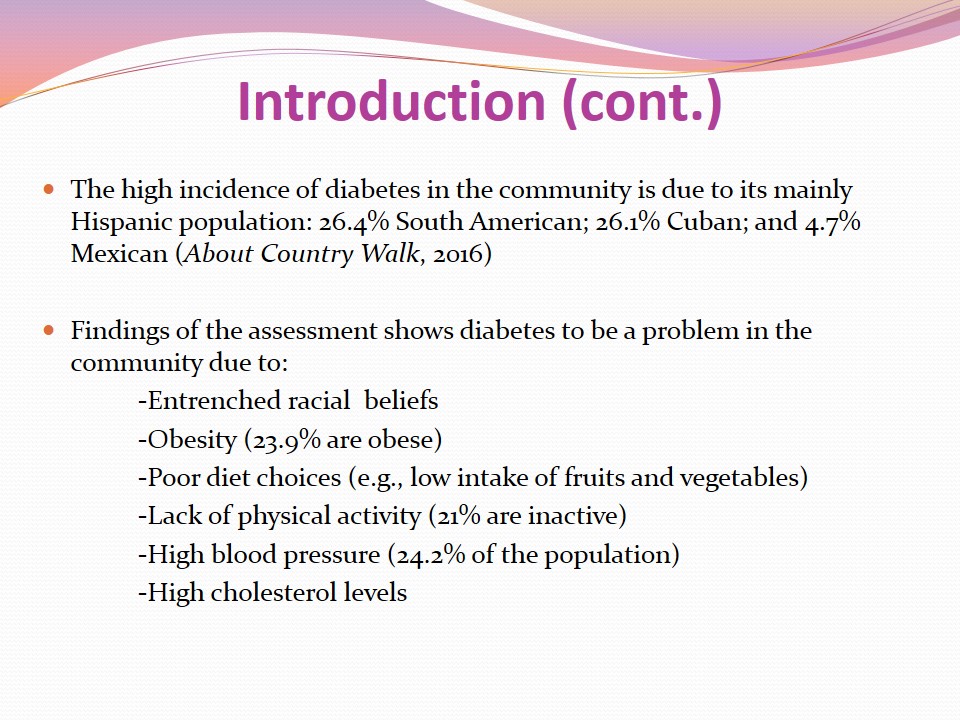
Proposed Intervention
Intervention
The outreach intervention will be used to address the obesity issues and poor diet choices related to the incidence of diabetes in the community.
The outreach intervention “locates populations-of-interest and provides information about the nature of the concern, what can be done about it, and how services can be obtained” (Public Health Interventions, 2001, p. 41).
The outreach intervention fits well in the public health intervention wheel , particularly in terms of “describing the scope of practice by what is similar across settings and describing the work of public health nursing at the community and systems practice levels as well the conventional individual/family level” (Public Health Interventions, 2001, p. 1).
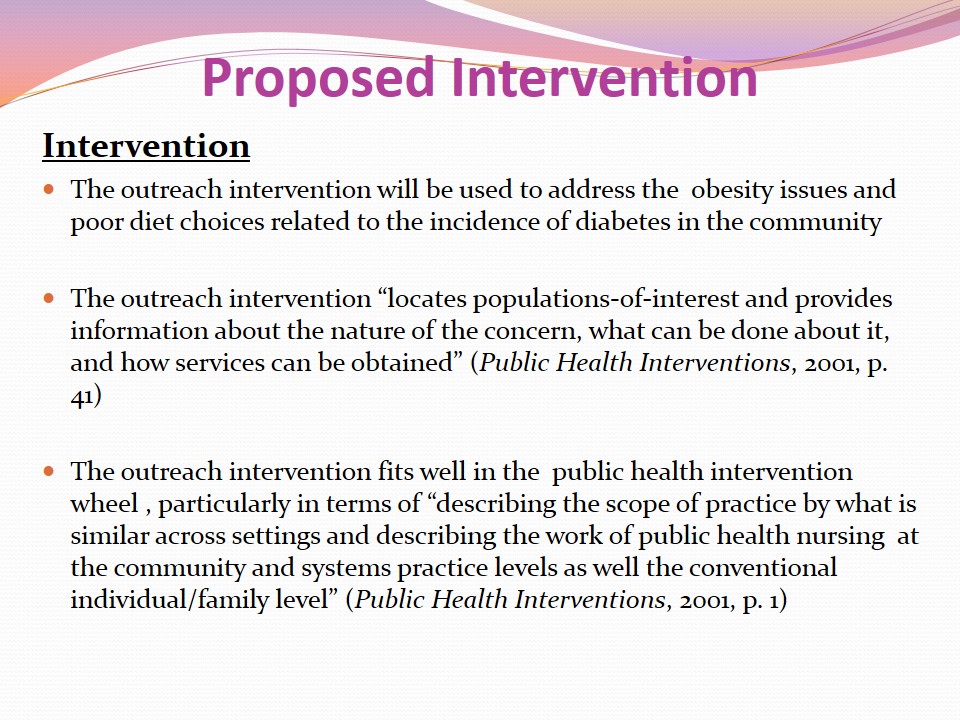
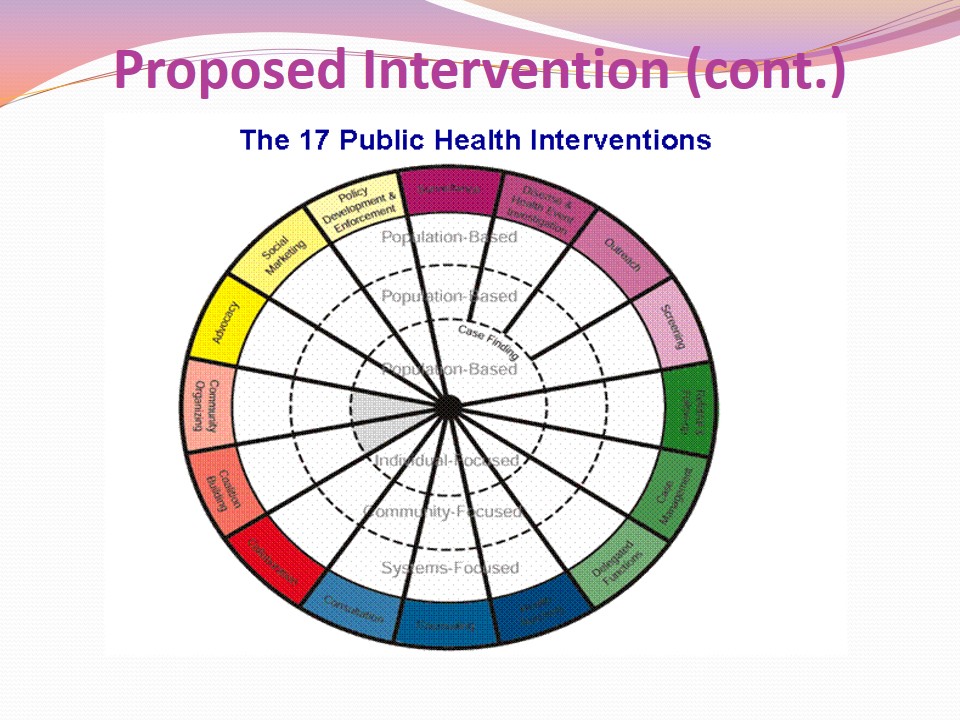
Target Population and Target Methods
Intervention will be community based, and will target Hispanic adolescents (13-19 years) most at risk for becoming obese and developing associated health concerns due to poor dietary habits.
Intervention will target schools, churches and local media outlets.
Aim is to repeat the intervention several times (at least thrice per month for six months) through the use of various communication outlets (e.g., local community radio, school lectures, church sermons, etc) to reinforce behavior modification.
Famous personalities (e.g., sportsmen and models) and lay health workers (LHWs) will be used to disseminate innovative, carefully designed materials and messages in radio call-in programs, local schools and churches (messages should be age-specific and culturally-appropriate).
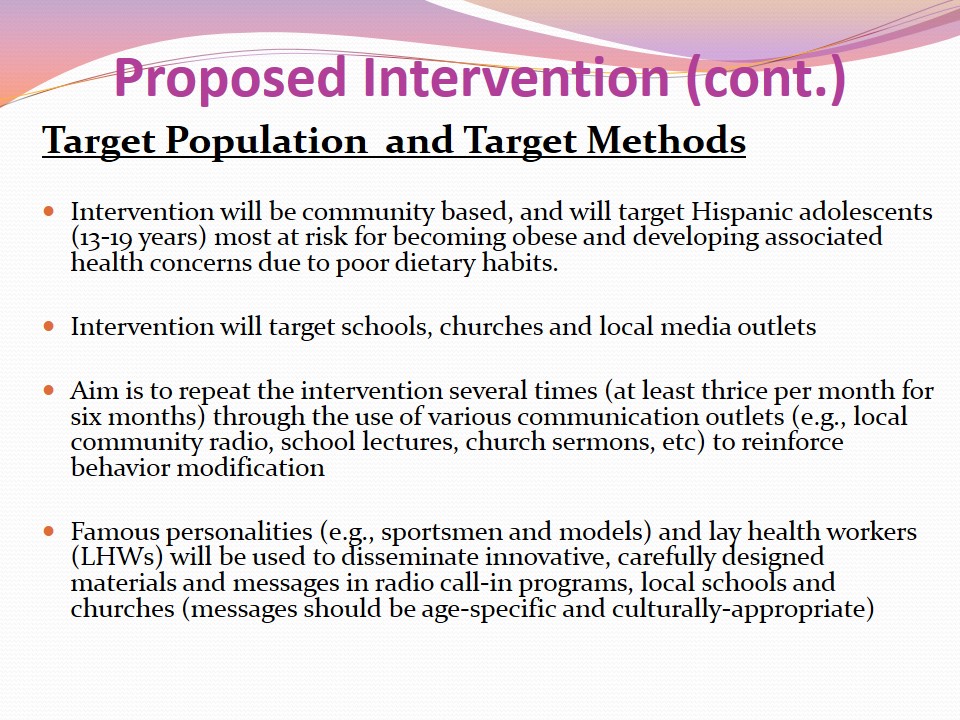
Strategies & Materials Used
- Community forums.
- Community and school fairs.
- Brochures (age-specific and culturally-appropriate).
- Pushcards.
- Radio call-ins hosted by influential personalities.
To encourage participation, radio call-in programs will run for four weeks after commencement and brochures will include hotline numbers which community members can use to ask for clarifications. Popular personalities will be used to increase appeal.
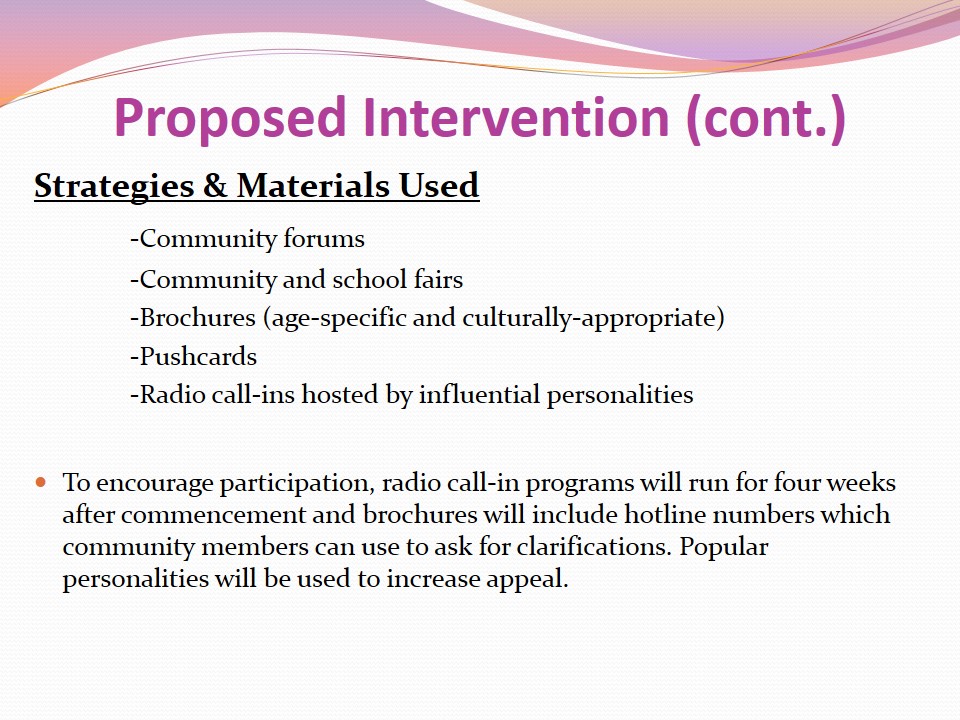
Setting and Role of Community Health Nurse
The community health nurse setting that will be in charge of rolling out the intervention is the nutrition promotion unit at the local health department.
The community health nurse in this unit will be charged with the following responsibilities:
- “identifying the issues to be addressed”;
- “describing the main characteristics of the target population”;
- “analyzing how demographic and other information may be used to develop an effective outreach”.

Roles of community health nurse
- “testing the outreach plan to see if it communicates the right message”.
- “implementing and monitoring the outreach plan”.
- “evaluating the results of the outreach implementation”.
- “identifying external and internal barriers to the outreach plan and seeking ways to address them” (Tembreull & Schaffer, 2005, p. 347).
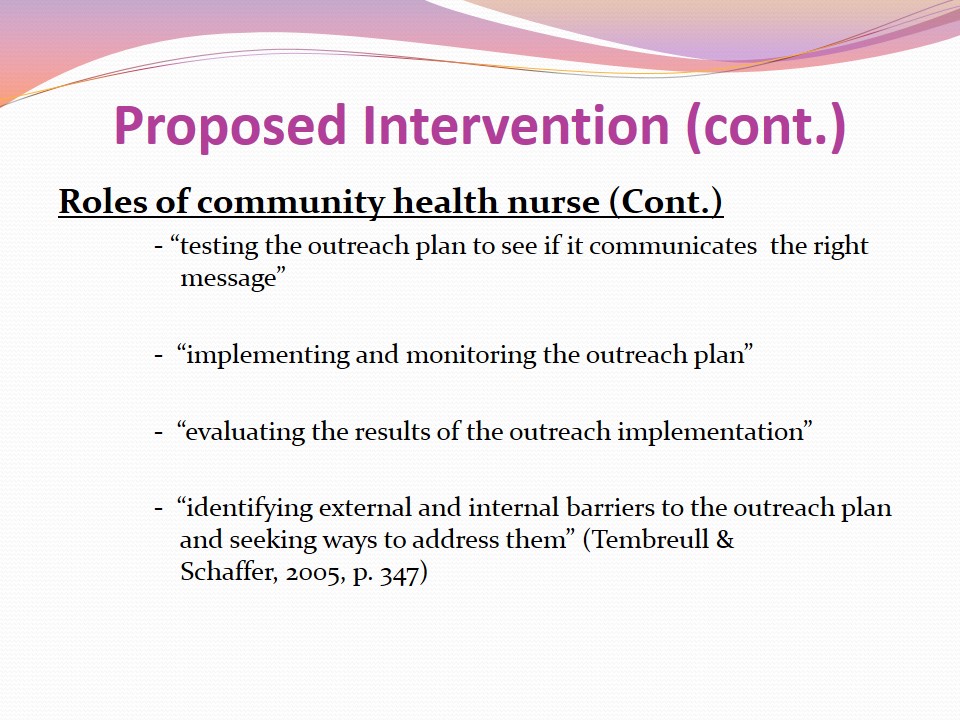
Collaboration and Strategy
The outreach program aims to collaborate with local media personalities, lay health workers (LHWs), church leaders, school heads, and motivational speakers to achieve effectiveness and wide coverage. Prominent community members will also be asked to volunteer in creating awareness.
A primary prevention strategy will be used to promote health among Hispanic adolescents (e.g., by demonstrating the importance of consuming fruits and vegetables, reducing the intake of fatty foods, and engaging in routine physical exercises) and also to protect against threats to health.
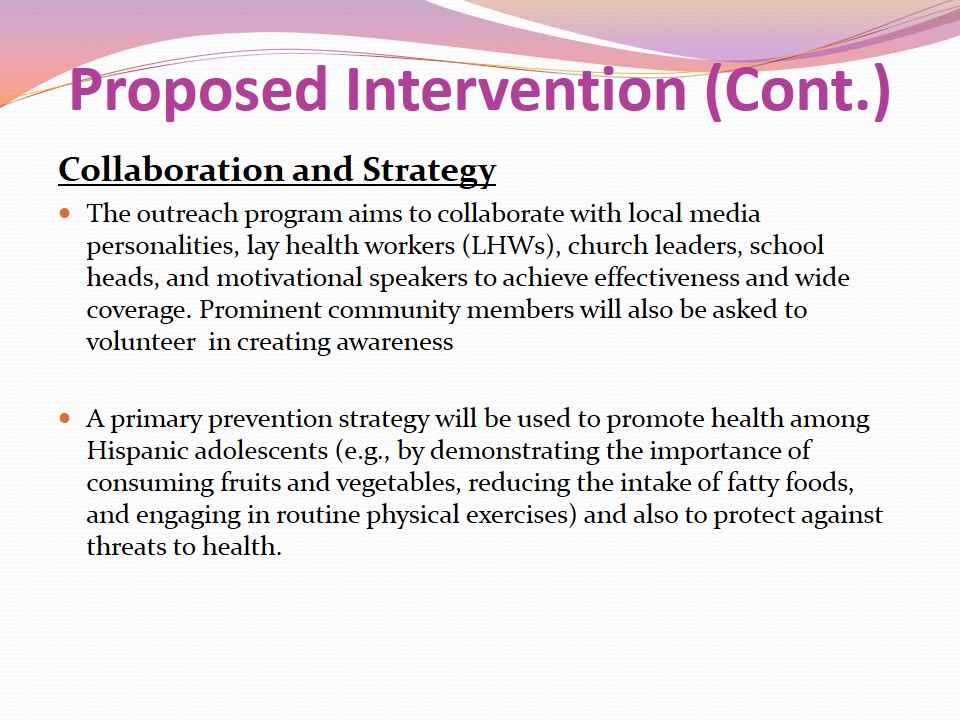
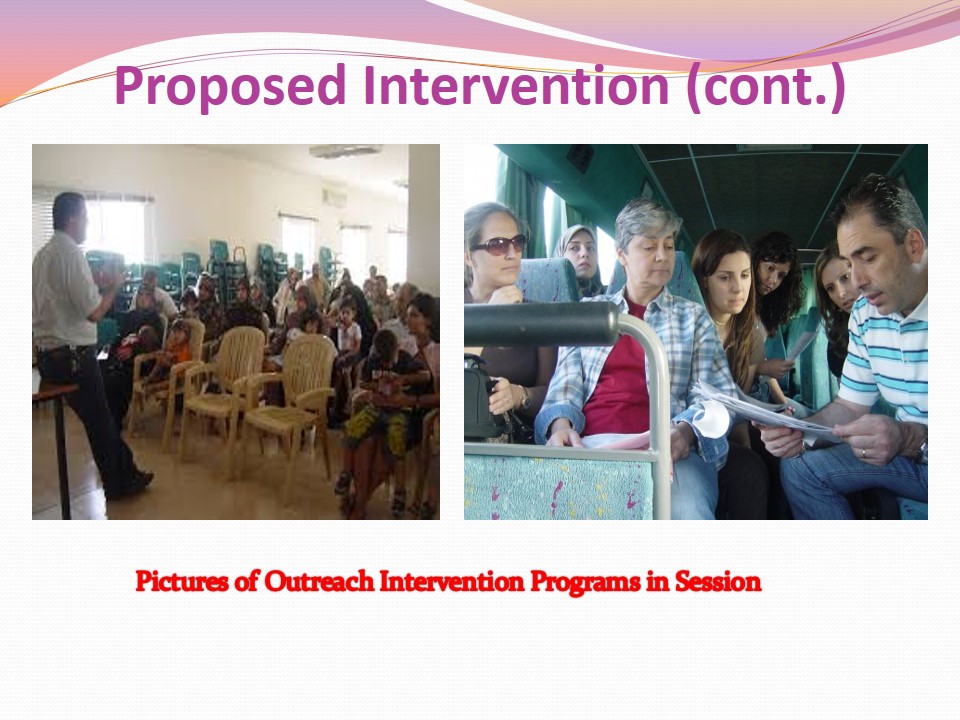
Intervention Justification
The problem of diabetes is a priority based on the fact that individuals of Hispanic descent not only suffer higher rates of morbidity and mortality related to diabetes than non-Hispanic white people, but are more likely to develop diabetic-related complications (e.g., retinopathy, kidney disease, and lower limb amputation) than other ethnic groups in the population (Hatcher & Whitemore, 2007).
Outreach interventions are highly effective in effecting behavior change, especially if such interventions use a combination of lay health workers (LHWs) and famous personalities to communicate the message.
One study found that the use of LHWs in community-based outreach programs is an effective strategy to increase cancer screening behaviors in underserved or vulnerable ethnic populations (Nguyen, Stewart, Nguyen, Bui-Tong, & McPhee, 2015).
Although LHWs are not health care professionals , they nevertheless receive some training to promote health and hence can be effectively incorporated into outreach programs meant to modify behavior among the targeted populations.
This study found that LHW outreach intervention is effective as social networks provide “the existing relationships, trust, and social and cultural norms among the network members for LHWs to rely on for influencing the participants to obtain CRC [Colorectal cancer] screening” (Nguyen et al., 2015, p. 2086).
Another study argues that public health nurses (PHNs) can “use the intervention of outreach to improve health status by locating at-risk or of interest populations, providing information about health concerns and linking the population to resources to address the health concerns” (Tembreull & Schaffer, 2005, p. 347).
Findings of another study demonstrated that “culturally specific outreach materials based on personal narratives are a promising population-based intervention to motivate rural smokers to consider cessation” (Butler et al., 2013, p. 44).
The authors of this study also contend that outreach interventions are effective in reaching special populations, incorporating community-based participatory strategies needed to modify health behavior, and establishing equitable relationships with diverse community members with the view to cultivating an enabling environment for behavior change.
Based on the findings of the reviewed studies, it is evident that the outreach intervention is an effective approach that can be used to modify the behaviors of Hispanic adolescents in the community.
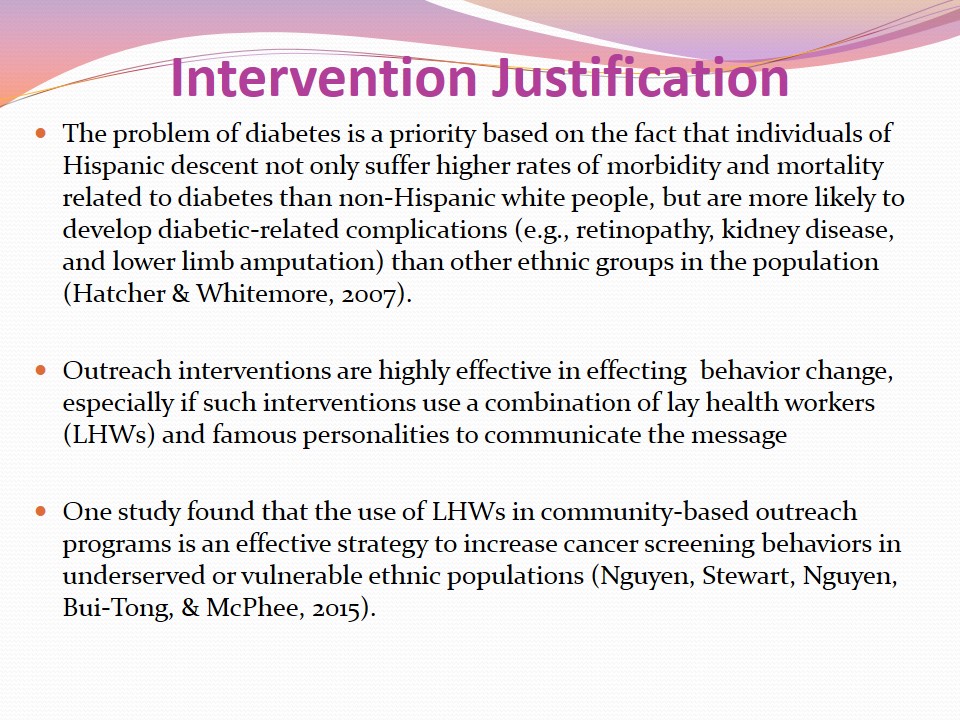
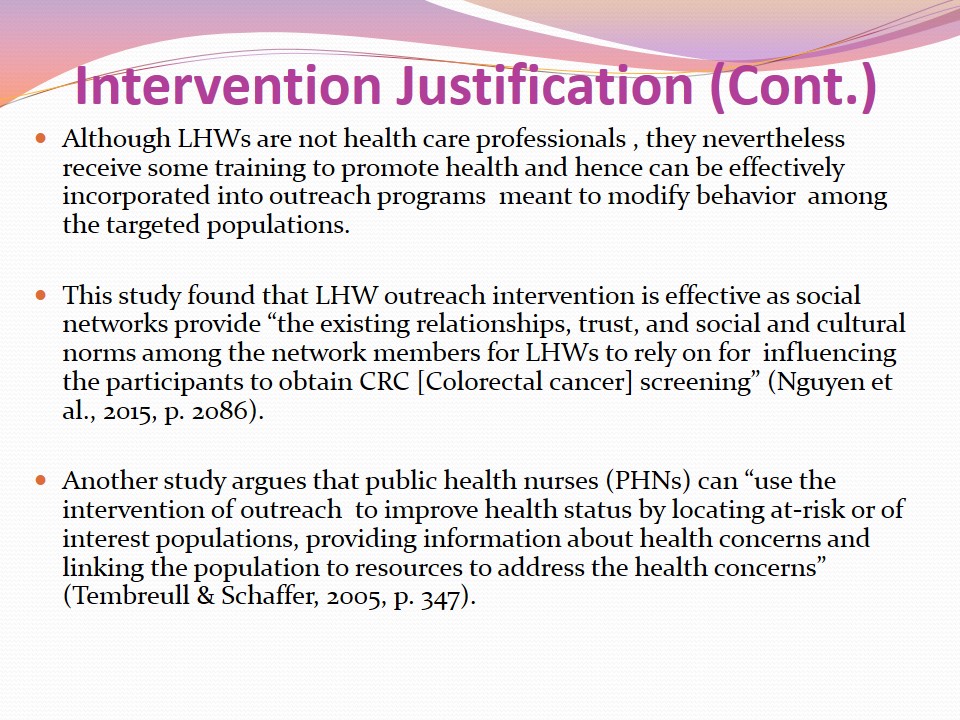
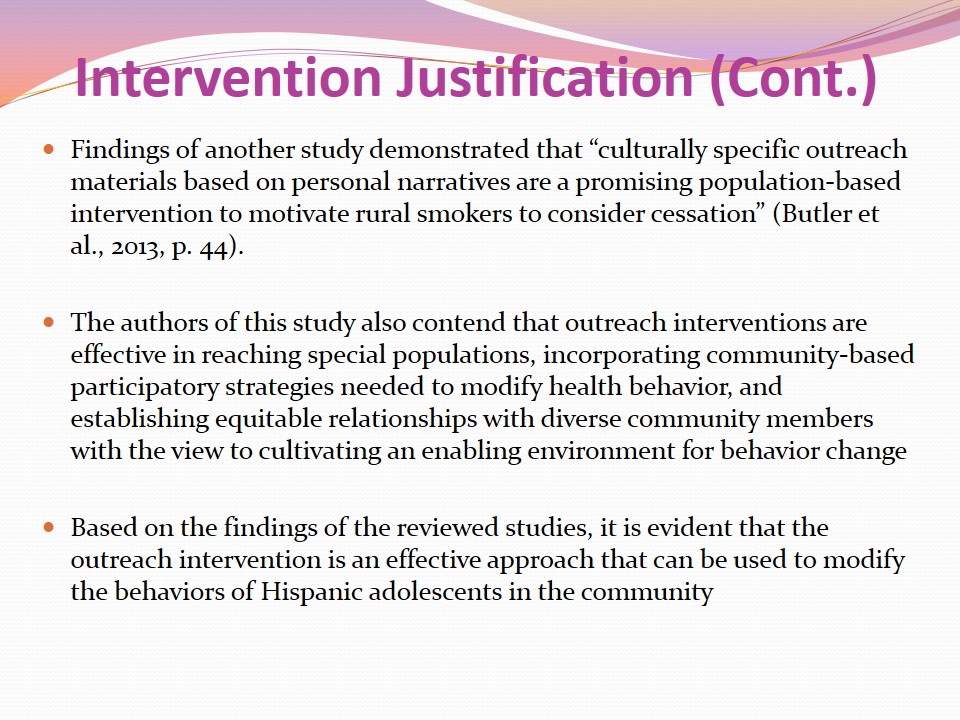
Proposed Evaluation Method
Method
- Interviews will be conducted with selected Hispanic adolescents pre and post intervention.
- This method is qualitative in approach.
- Interviews provide deep and insightful information related to people’s attitudes, value systems, perceptions, and world views (Turpin, Asano, & Finlayson, 2015).
- Although they are time-consuming and costly to undertake, they represent the best approach to understand how the intervention has modified the behavior of Hispanic adolescents from their “own” description of personal experiences.
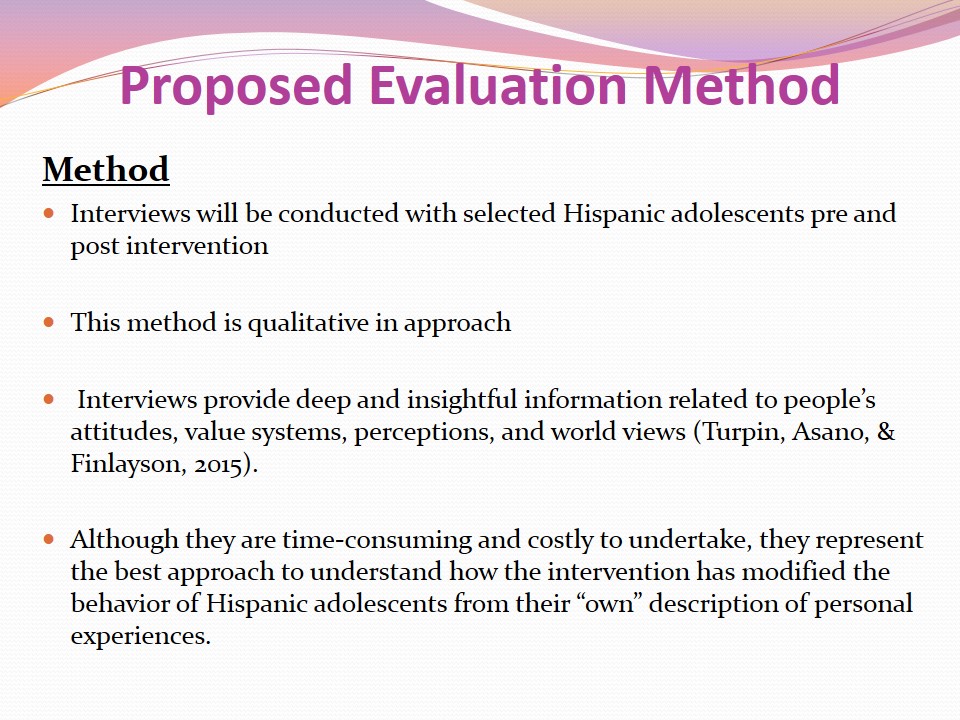
Desired Outcomes
- Behavior change to reinforce healthy habits.
- Increased consumption of fruits and vegetables among the targeted population.
- Increased enrollment to physical exercise programs within the community.
- Decreased intake of fatty foods.
- Routine observance of body weight.
- Reinforcement of health-seeking behaviors among the targeted population (e.g., routine visits to health clinics for medical checkups.
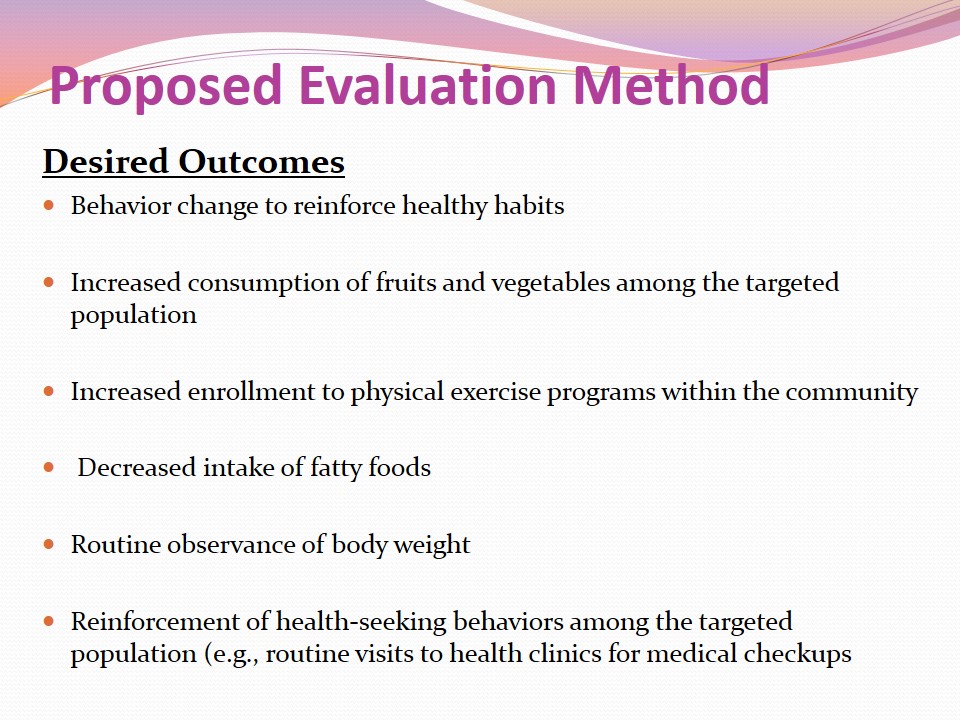
Sample Interview Questions (post-Intervention)
- Can you describe how your consumption of fruits and vegetables have changed after participating in the outreach intervention?
- Has your attitude towards engaging in physical exercises changed and, if yes, how has the change assisted you to maintain a healthy body weight and lifestyle?
- What is your attitude towards the consumption of fatty and unhealthy foods?
- How has the intervention affected your behavior in terms of seeking help for common medical complications?
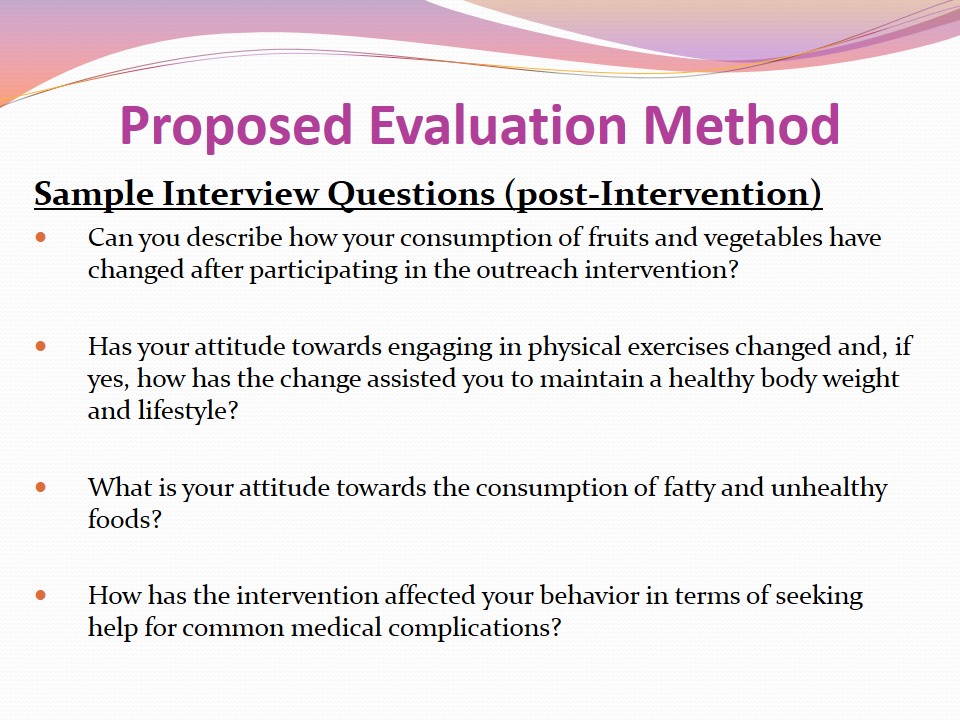
Short-term Impact
- If the intervention is successful, it will minimize hospital visits and other morbidities/disabilities associated with poor dietary habits and lack of physical exercises.
- The community will also have a healthy population which is aware of adverse health outcomes associated with poor dietary habits and lack of physical exercises.
Long-term Impact
- Cases of diabetes in the community will decrease as community members will be well endowed with the knowledge of how to address the risk factors associated with the disease.
- Community members will live longer and quality of life indicators will improve substantially as diabetes will no longer be a health burden.
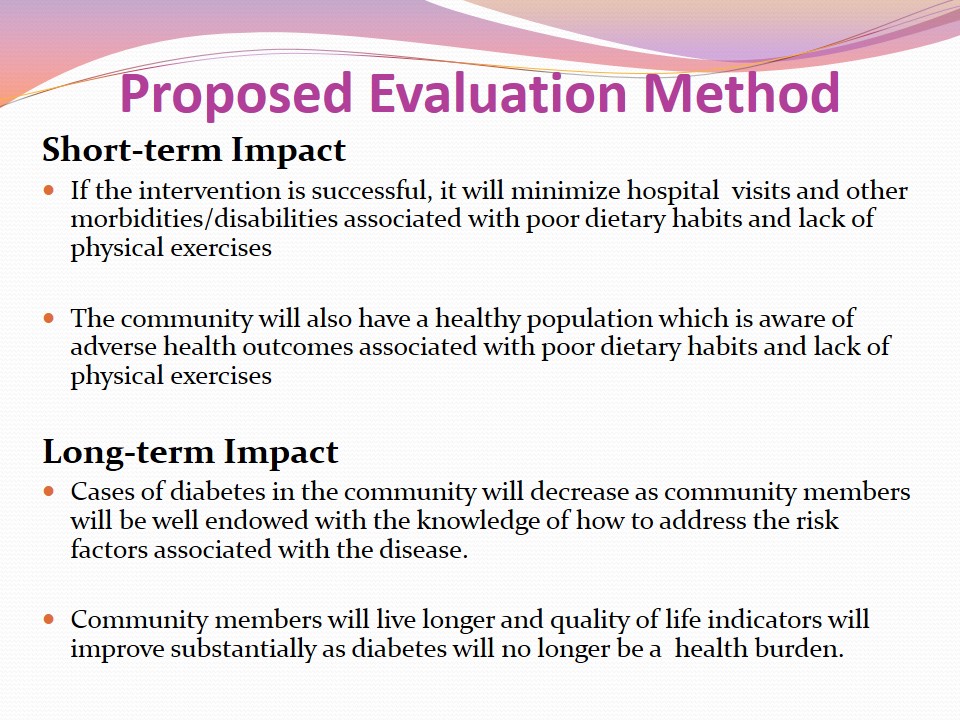
Summary
This presentation has demonstrated how an outreach intervention can be used to address the diabetes problem affecting Country Walk community through modification of behavior.
The presentation has also proposed the interview method as an effective evaluation tool in assessing the success of the outreach intervention.
The roles of the community public health nurse have been well documented, as well as the importance of including lay heath workers (LHWs) and famous personalities in an outreach intervention targeting Hispanic adolescents.
A primary prevention strategy is important when using the outreach intervention as it aims to not only promote healthy behaviors (e.g., by demonstrating the importance of consuming fruits and vegetables, reducing the intake of fatty foods, and engaging in routine physical exercises), but also to protect against threats to health.
Important personalities have been included in the outreach intervention due to their appeal to the young people, while lay health workers have been included due to their knowledge in health issues and capacity to develop social networks and trust within the community.
It has also been demonstrated that age-specific and culturally-appropriate health education materials (e.g., posters and brochures) can be used to strengthen the outreach intervention by creating awareness on the modifiable risk factors associated with diabetes.
A number of studies have found the outreach intervention to be an effective approach that can be effectively used to trigger behavior modification among at-risk populations (e.g., Hispanic adolescents who are at risk of developing diabetes due to poor dietary habits and lack of physical exercises).
It is important to consider cultural perceptions of the targeted population if the outreach intervention is to succeed.
Based on this presentation, it can be concluded that the outreach intervention can be used to assist the targeted population in Country Walk (Hispanic adolescents) to modify their behavior and hence succeed in addressing the major risk factors associated with diabetes.
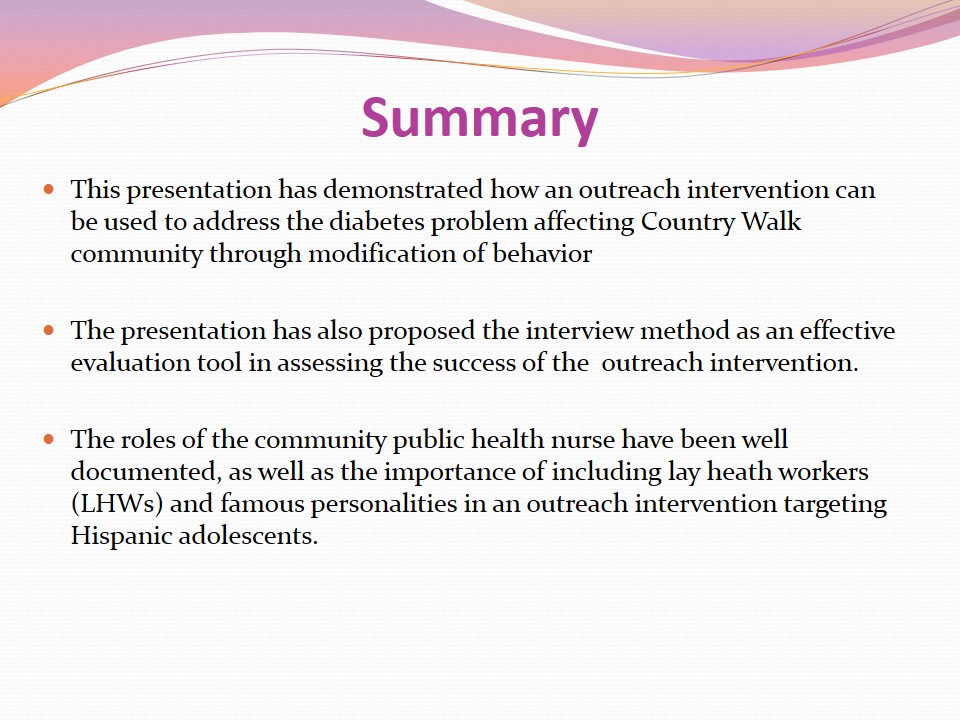
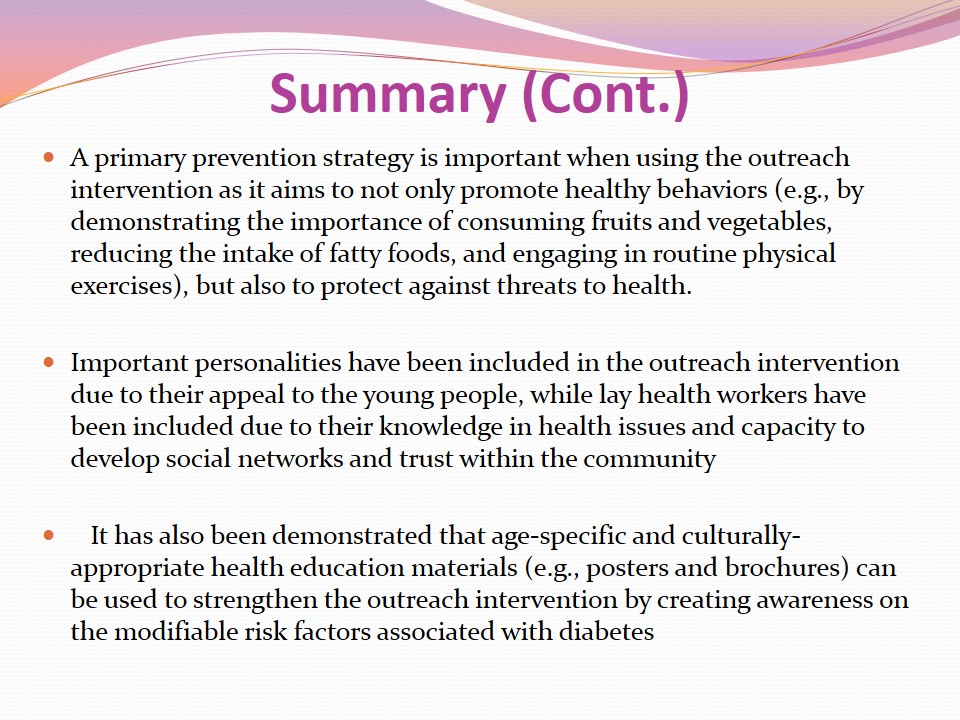
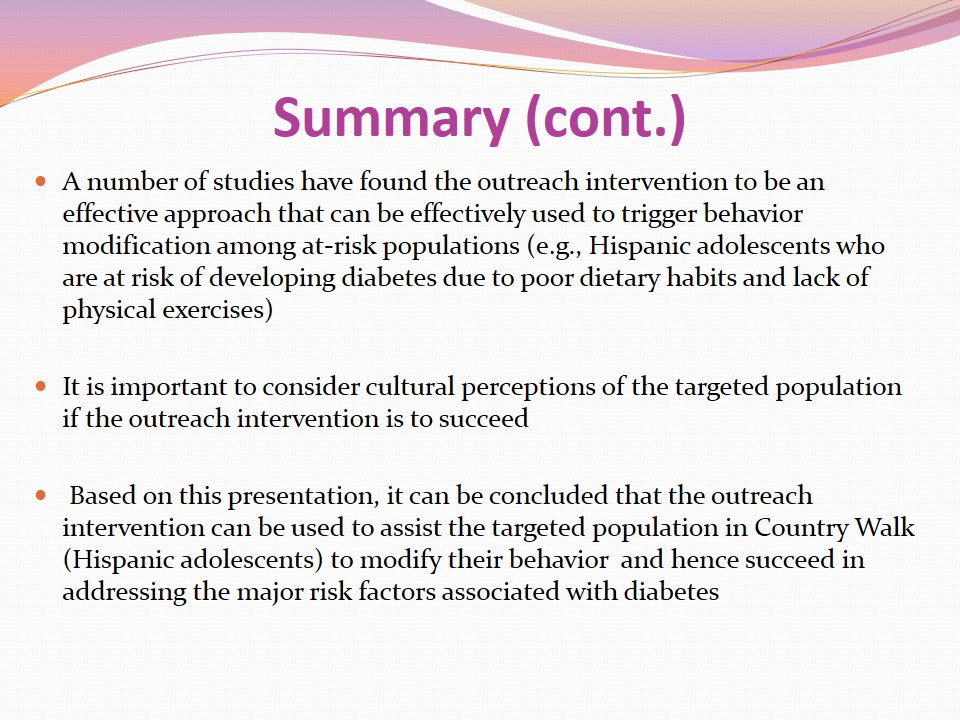
References
About Country Walk. (2016). Web.
Butler, K.M., Rayens, M.K., Adkins, S., Record, R., Langley, R., Derifield, S.,…Hahn, E.J. (2013). Culturally-specific smoking outreach in a rural community. Public Health Nursing, 31(1), 44-54.
Hatcher, E., & Whitmore, R. (2007). Hispanic adults’ beliefs about type 2 diabetes: Clinical implications. Journal of the American Academy of Nurse Practitioners, 19(10), 536-545.
Nguyen, B.H., Stewart, S.L., Nguyen, T.T., Bui-Tong, V., & McPhee, S.J. (2015). Effectiveness of lay health worker outreach in reducing disparities in colorectal cancer screening in Vietnamese Americans. American Journal of Public Health, 105(10), 2083-2089.
Public heath interventions: Applications for public health nursing practice. (2001). Web.
Tembreull, C.L., & Schaffer, M.A. (2005). The intervention of outreach: Best practices. Public Health Nursing, 22(4), 347-353.
Turpin, M.J., Asano, M., & Finlayson, M. (2015). Combining qualitative and quantitative data collection and analysis methods in understanding multiple sclerosis fatigue management. International Journal of Qualitative Methods, 14(2), 53-68.